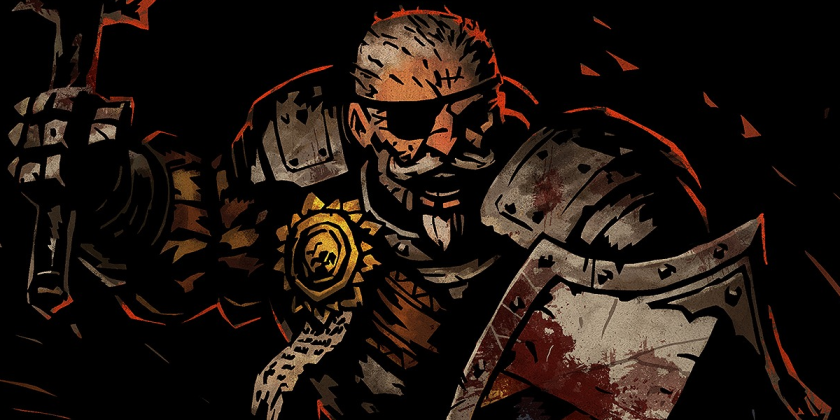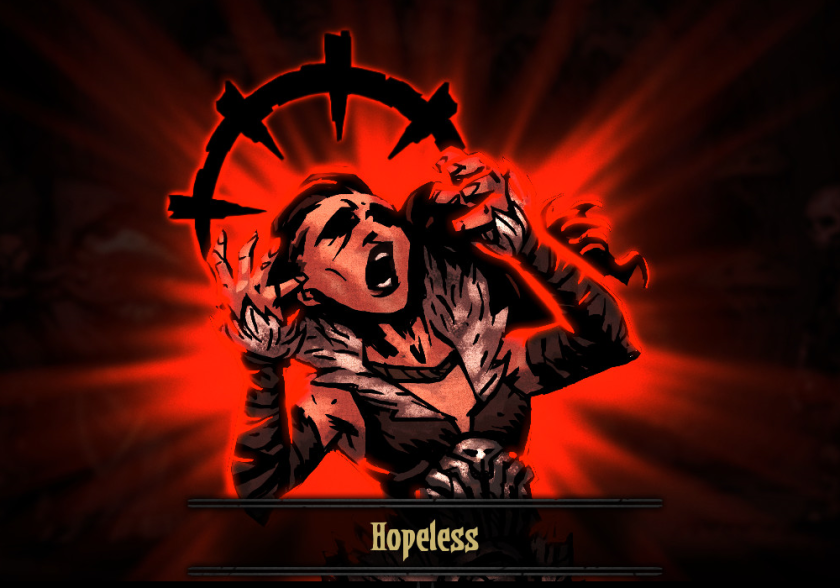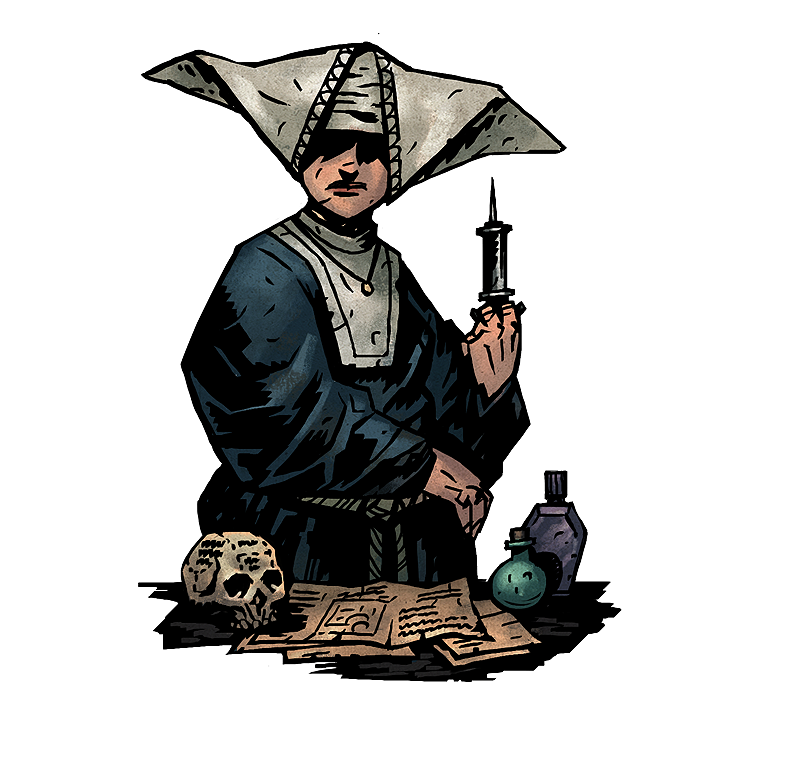“The shifted corridors and sloped vaults of our ancestry are beginning to feel familiar.“
In Part 1 of this article we discussed how Darkest Dungeon laid out the table in terms of its tense, foreboding gameplay and setting by using presentation and the tuning of otherwise basic, unremarkable mechanics. While generally applause-worthy, these things alongside the obvious aspects of art-style, writing, and Wayne June’s incredible performance as the narrator, only serve to surround the game’s star actors: Madness and Degeneration.

“Injury and despondence set the stage for heroism… or cowardice.”
In Darkest Dungeon the bodies of your heroes are not the only things that are tried and broken, but their minds as well– The sight of otherwordly horrors, the ominous prophecies of madmen, and even the faltering or madness of allies can drive your heroes to Afflictions such as rage, depression, and insanity– Or, perhaps with some luck, embolden them to a Virtue the face of death and danger. Accompanying every unit you command’s HP bar is the Stress meter, ranging from 0-100 at which point the hero is pushed to the brink, and then over itself for 101-200 where even their body fails in terror. Every terrifying blow and revelation slowly inches up the bar, representing the deterioration and unhinging nature of those pushed through hell with fire and steel.
Stress is not like normal damage, in fact outside of camping there are very few ways to heal it during an expedition; the nature of Stress is that it accrues, driving good men mad and clinging to soldiers until the turn to suicidal husks or abusive cowards. More worryingly however, is that trauma remains even when mundane wounds are healed; that means that even once you return to the hamlet your champions retain their stress, and if they were pushed to the brink, their mind-broken Affliction; which leaves sending out significantly traumatized individuals a worrying, or even outright dangerous option.
While Stress is a different kind of wound, the kind the creeps up from the darkness and grows until it overwhelms, it thusly has a different kind of answer: Just as mundane bandages and anti-septics save your heroes from jagged and festering wounds, their minds must be laid to rest in the tavern or the temple. Back in the Hamlet, in addition to arming and training your soldiers against corruption, you must also treat you heroes, paying large sums of gold to let them drown their sorrows, meditate to find inner peace, or pray until they are delivered from madness; however, there are far more permanent scars that cling to your heroes after victory or defeat in the dungeons…

“There can be no hope in this hell, no hope at all.”
Throughout each delving into the hazardous darkness, your heroes will come under fire by all manner of terrifying, putrid, and otherworldly abominations, and while the freshest wounds heal and terror eased, every adventure can leave scars on a champion of the estate; if they did not arrive with several already. Quirks and Diseases are semi-permanent modifiers to characters that define them, which each mercenary arrives with when they are available to recruit, but more importantly they accrue upon each expedition, often reflecting the actions that inflicted them with such crippling facets, such as coming across and ancient tome and being inflicted with a fear of what laid inside, or contracting a wasting sickness from the bowels of some possessed beast.
While some of these Quirks can be righteous or valorous, such as the hero adapting to dark environments or being driven by hatred of some type of foe, negative Quirks and the separately-tracked Diseases range from acceptable inconvenience to damning. Each of these accrued flaws clings to your hero, defining their capabilities or exposing them to new dangers, and over time negative Quirks will become locked-in; establishing a near-permanent psychosis for that adventurer.
However no adventurer can be crippled forever, short of death, and in the halls of the hamlet’s Sanitarium your heroes may find respite from themselves– For a cost; in fact the removal of locked-in quirks is one of the most expensive gold-sinks in the game; and should you leave the career of a champion in the hands of madness, before long they will be withered and useless; riddled with diseases and vastly limited by their quirks short of thousands upon thousands of gold. Indeed, to restore a beloved mercenary, you would have to pour out enough coin to outfit an entire party…

Pay no heed to the lame horse, nor the broken man.
When you are finally confronted with the hard choices and self-asked questions is when the true malice of Darkest Dungeon’s key mechanics shine. Many players first approach Darkest Dungeon like many other strategy RPGs or Dungeon Crawlers, grooming every character, outfitting them to their debt, and holding the line to save their precious lives– But at some point, every player finds their patience or decency tested; and they begin to shy away from moral action and righteous direction, risking lives for loot and sending scantily prepared parties into pure darkness, and whether they know it or not they’ve uncovered the core principal of Darkest Dungeon: Human lives are the only expendable resource.
For all the difficulties and expenses I’ve listed above, with how heroes degenerate into infirmity and psychosis and the associated expenses, once must wonder how you could keep them fit and sane; and the easiest answer is simply to not. Why bother healing a madman or curing a warrior when you can discard them and hire a fresh face; or even better, send a party of your broken and damned into hopeless, under-prepared expedition so the survivors might carry back a portion of the profits.
An early milestone many new players strive for is something afforded the small price of 2 upgrades on the hamlet’s stagecoach, one of which you can purchase after your first quest, you will find yourself with a steady income of 4 lv0 adventurers– Enough to form a full party, and this is the key to how Darkest Dungeon lures its players into sacrificing the lives of other for their own gain. What usually follows is the revelation that the darkness holds even greater loot from curios and slain foes, at the risk of danger, as well as the lucrativeness of curios with the proper interaction, or bare-handed scrounging that chances permanent infirmities for loot.
Before long any player willing to sacrifice the lives of those that trust them will find himself pawning off naked parties into the darkness to scrounge like vermin only to die like them as well, and when the party becomes overwhelmed, maddened, or simply fat with loot you abandon your expedition and either abandon your abused fighters or send them back in until they finally perish feeding the hamlet. However, there’s something very, very important to realize about all of this, and it’s perhaps the game’s most sinister trick of all: The game never tells you to do any of this.
That’s right, the strategies I’ve just described in a manner that makes them seem commonplace are not ever told to you or even described in game, but they are hinted at through incentives and mechanics. In Darkest Dungeon you are not given an arbitrary narrative setpiece or some dialogue wheel with a ‘good’ and ‘bad’ option, you are tempted with an earnest and game-defining opportunity that invokes guilt for even recognizing it. Almost a dozen times I have introduced someone to this game, and without fail or guidance they have all discovered this strategy in-game, and almost all of them have used it to great effect.
I feel like this is Darkest Dungeon’s masterstroke: The ability to wordlessly coerce a player into making a real, tangible moral choice; and with only the haunting narration of the Ancestor congratulating you on discarding useless mercenaries or mocking their deaths in the pursuit of funding your crusade to accompany their bloating coffers.
However, as spectacular as I might find this game’s greatest accomplishment, it is undermined by many things; and while the systems that surround its core mechanics are fantastic and immersive, there are still holes in the tapestry woven by Red Hook…
[To be continued in Part 3]
Part 3 is to be completed at an indeterminate time in the future, given the release of The Crimson Court and future developments.

